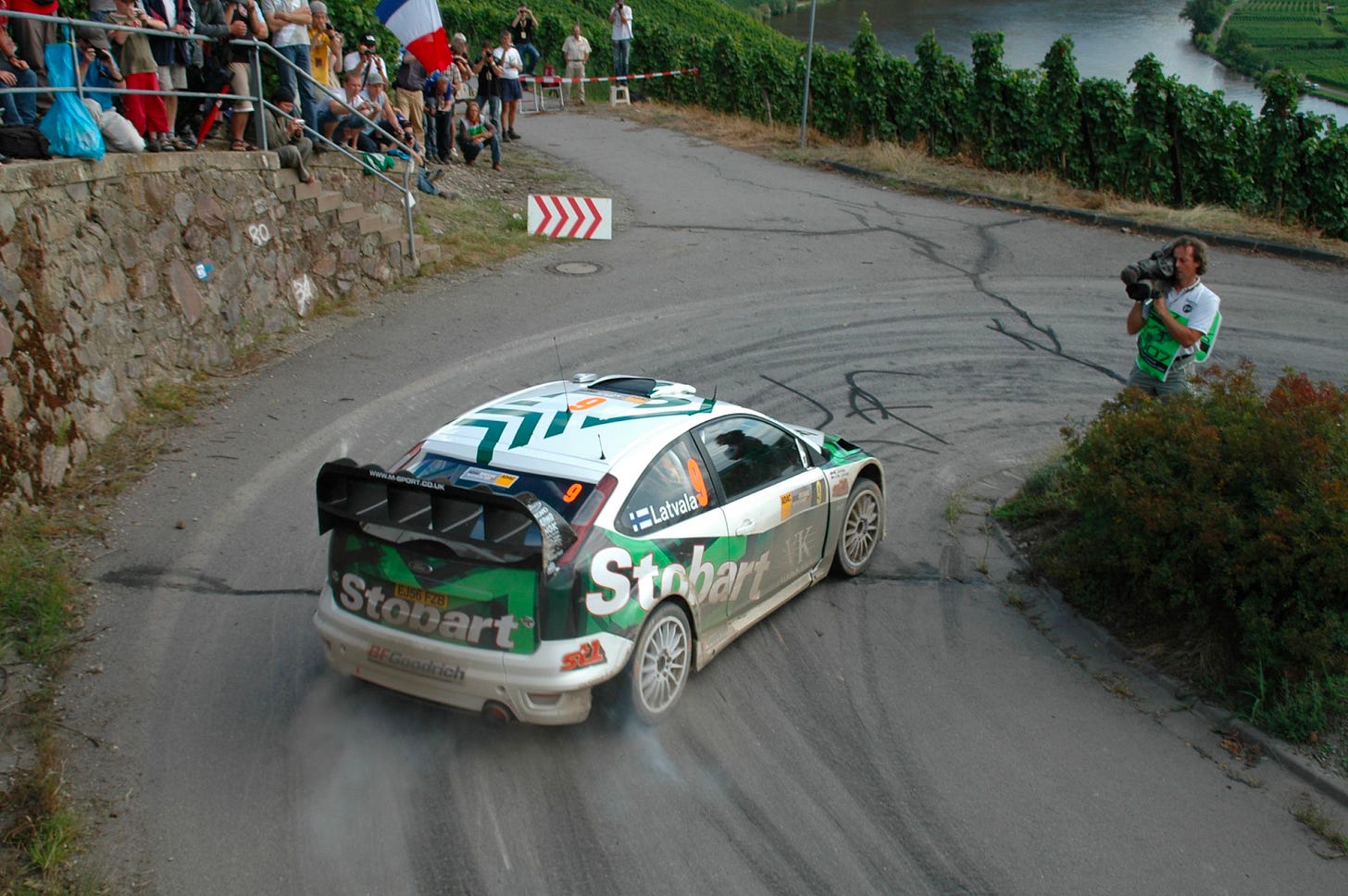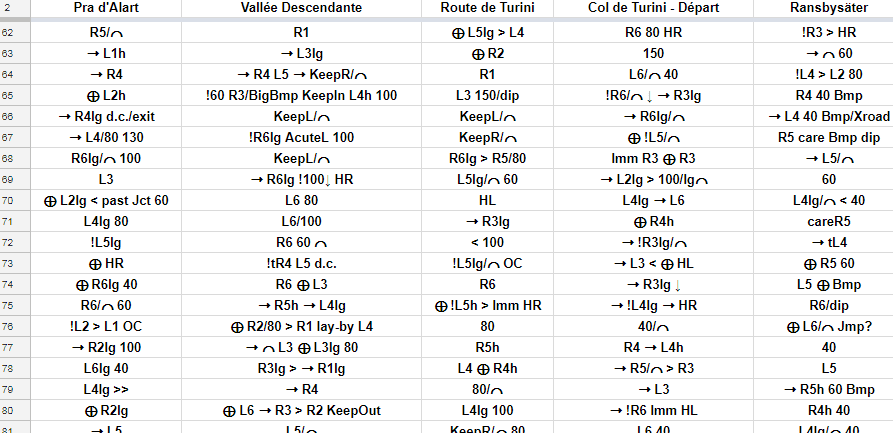The Pacenotes Edition
On rallying, shorthand, and high stakes
Graydon is the Head of Marketing at Fractal Software. He’s written several WITIs over the years, but his favorites are probably the Jazz Legend and Mallmann editions. He almost bought a rally car with a buddy a couple years ago, but their wives convinced them it was a bad idea. At times he regrets that decision.
Graydon here. The rallying community is abuzz with the news that nine-time world champion Sebastian Loeb will be returning to the series after a two-year hiatus when he competes in the Monte Carlo Rally in late January. A true racing legend, he and his co-driver Daniel Elena dominated rallying in the late aughts and early teens.
For the uninitiated, rallying is a century-old category of motorsport in which a driver and a navigator race point to point on closed roads in a series of “stages,” the total time it takes a team to complete all the stages determining the winner. The World Rally Championship (WRC), is the top level of the sport, equivalent to Formula 1 in open wheel racing or the NASCAR Cup Series for stock cars. The WRC takes its competitors across the globe, from the snow-covered forests of Finland to the dirt roads of Argentina to the perilous cliffs of Corsica. As much as anyone in motorsports, rally drivers operate on the limit: they are trying to squeeze every ounce of pace out of their vehicle, often while skirting the edge of a ravine, narrowly avoiding the trunk of a tree, or accelerating through a slippery corner crowded with eager fans, missing them by margins that never cease to shock me.
Jari-Matti Latvala driving his Ford Focus RS WRC 06 at the 2007 Rallye Deutschland. [Via Wikipedia]
But when Loeb slams on the gas and whips off the line in the first stage of this season’s opener, his former co-driver Elena won’t be seated alongside him. Instead, Isabel Galmiche, a longstanding member of his gravel crew (a team that drives and reviews course conditions before the race), will be riding shotgun. That might sound inconsequential—Loeb is the one steering, after all—but all eyes will be on Galmiche as she assumes a critical responsibility. She will be reading the pacenotes.
Why is this interesting?
Pacenotes are the guides rally drivers use to navigate each stage of the event. Written in shorthand, these highly detailed instructions help the driver complete the stage safely in as little time as possible. Masterpieces of information heuristics, pacenotes help drivers anticipate the details of a route: the distance between major features, the sharpness and direction of corners, the camber and conditions of the road, and special instructions that suit a driver’s style or preferences.
There is no standard system for creating pacenotes, although they tend to fall into a few broad categories. Descriptive-first systems describe the severity of the turn then the direction: a fast right corner would be notated FR, whereas a hairpin to the left would be described as HPL. On the other hand, a direction-first system would read RF (right fast) or LHP (left hairpin). Meanwhile, a figure-based system uses numbers to describe the severity of the turn. Most teams who take this approach use 6 for fastest and 1 for slowest, with the numbers corresponding with the car’s gears. A 6R is a righthander you’d take flat out in 6th gear, while a 1L is a sharp left turn taken in first. But even amongst those who use the figure-based system, 6-fastest is by no means universal. Some drivers invert the order—1 fastest, 6 slowest—while others use entirely different scales. Whatever gets you to the end of the stage quickly and safely is the best method.
Shockingly detailed manual pacenotes made for Dirt Rally, a fairly realistic rally video game
The more sophisticated a driver, the more detailed pacenotes he or she will want. Notes often include whether a corner opens (“<”) or closes (“>”), impacting how a driver approaches the turn. For example, a driver might accelerate into the apex of a corner that opens, knowing that there is room to slide into the exit beyond the blind spot. Bumps (Bmp), jumps (Jmp) and crests (Cr) will all be captured, and may include a note about their size (SmJmp vs BigJmp, for example). Exclamation points signal a need for caution: “!” means there’s a chance you might crash. “!!!” means that, if you crash, there is a chance you might die.
Suffice it to say, delivering pacenotes timely and accurately is a high stakes activity. Mistakes can have severe consequences. Rumor has it that two-time champion Carlos Sainz once crashed during Rally Argentina because his co-driver Luis Moya accidentally turned two pages of the notes at once. The no longer accurate directions caused Sainz to take a turn at the wrong speed and roll the car.
Creating pacenotes is no less intensive an activity. For those building their pacenotes from scratch, they are often limited to just a couple reconnaissance or “recce” passes through the stage route. The first will be taken slowly, the second more quickly, but neither will be at true race pace. Will that bump be a jump when taken flat out? Is that righthander best taken in 3rd or 4th gear? The more experienced a rally team is, the more effectively they can create the sort of detailed pacenotes that allow them to gain miniscule advantages at various points throughout the stage and fight for the fractions of a second that can separate winning from losing.
The 2022 Monte Carlo Rally, which runs January 17-23, will consist of almost 300km of racing across 17 stages. Unlike a racing circuit, it’s impossible to memorize the course and drive it at the speeds needed to win. That’s where pacenotes come in. When you need to drive faster than you can think, have someone else do the thinking for you. In any motorsport, there is a tension between speed and safety. Pacenotes are a snapshot of that tension, an attempt to boil down what it looks like to push limits of the driver while keeping the car on the road into just a few characters. (GG)
Quick links
The original pacenotes were developed by F1 driver Stirling Moss and journalist Denis Jinkinson for use in the 1955 Mille Miglia, a legendary but now defunct 1000-mile road race in Italy. They used hand signals because the open car was too loud for verbal communication, and the notes are rumored to have characterized corners as “saucy” and “dodgy,” among other frankly hilarious terms.
It’s impossible to mention rally racing without mentioning Group B, an infamous class of rally racing from the 1980s. Considered by many rally enthusiasts to be the golden age of the sport, Group B cars were powerful and sophisticated, but the class was outlawed after several major accidents caused both drivers and fans to lose their lives.
If the aesthetics of Rally pique your interest, watchmaker Autodromo has an entire line inspired by the Group B era. The Series 2 Safari is an everyday wear for me.
The 2022 WRC Calendar, if you’re interested in following along this season.
WITI x McKinsey:
An ongoing partnership where we highlight interesting McKinsey research, writing, and data.
Improving organizational performance and sustaining it over time remains a challenge that few companies have cracked. One key finding from our latest McKinsey Global Survey? Three core actions during a transformation can help predict value capture. New research on the topic could up your organization’s odds of achieving its full transformation potential.
Thanks for reading,
Noah (NRB) & Colin (CJN)
—
Why is this interesting? is a daily email from Noah Brier & Colin Nagy (and friends!) about interesting things. If you’ve enjoyed this edition, please consider forwarding it to a friend. If you’re reading it for the first time, consider subscribing (it’s free!).




I hate to pick nits, but, while great, Arctic Rally Finland is not a World Rally Championship event, even though WRC-spec cars are allowed and indeed necessary for winning the overall event. This is because the Neste Rally Finland is a more established World-class race held in August, and it wouldn't fly to have two WRC rallies in the same country every year. The main WRC Series winter event is the Swedish Rally, which follows Monte Carlo in the calendar.